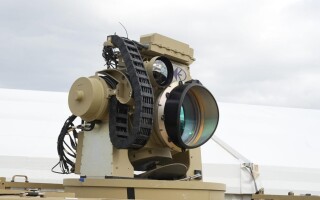Shipboard electronics gain tactical edge through ruggedized commercial server technology
StorySeptember 08, 2023

Innovators in the area of commercial semiconductors are continuously developing new capabilities in silicon; defense system designers can leverage these advances to build open architecture-based processing solutions. When intelligently packaged for reliable deployment at the edge, the latest commercial data center technologies can advance mission capabilities for the defense and aerospace sector.
Data-intensive applications, such as sensor fusion, artificial intelligence (AI) and high-performance computing (HPC), have been bottlenecked by technologies that do not adequately allow data to flow seamlessly between peripheral devices and the CPU. Add to that ruggedization requirements found in marine/shipboard environments: Finding a viable means to provide high performance data access in a compact footprint becomes even more of a challenge.
Moving data quickly from one component to the next is critical to overall server performance. And at a higher level, servers deployed to move that data must communicate with each other and with displays that form the human interface.
Developments in rugged server technologies are now bringing data center-class compute performance to aerospace and defense deployments, particularly in space-constrained environments for command-and-control assets. This is enabling AI-based tactical edge computing in critical areas, like signals intelligence (SIGNT), electronic warfare (EW) and C4ISR, for real-time threat assessment and mission-critical decision-making on airborne, surface, and subsurface combatants.
Why use commercial technologies?
Oftentimes, the search for the right rugged server systems starts with identifying the latest commercial technologies available, then taking the needed steps to ruggedize and package these technologies so they can be utilized in the field, where the system will endure environmental challenges like vibration, shock, saltwater, humidity, etc.
For example, a system designer is looking for a rugged rack server with the latest chip-based acceleration technology to reduce latency and calculate deep learning datasets for inferencing, prediction and real-time decision-making.
System integrators want a rugged rack server that can be deployed using the latest commercial compute capabilities in a SWaP-optimized form factor. For shipboard applications, this includes both surface and subsurface platforms to enable quick sensor processing. These enhanced capabilities are increasingly critical for the end users, who need the most enhanced compute capabilities to make mission-critical decisions in stressful environments.
As a frame of reference, the data center-class 4th Gen Intel Xeon Scalable processors (formerly codenamed “Sapphire Rapids”), low-latency PCIe 5.0 fabrics and the powerhouse NVIDIA H100 GPU are highly sought-after commercial technologies currently driving the design of rugged servers for military and defense applications.
The inclusion of high-speed DDR5 memory and Compute Express Link (CXL) means today’s rugged servers can offer robust, scalable computing ready to handle the challenging workloads in edge computing applications, even those in maritime environments. (Figure 1.)
[Figure 1 ǀ Rugged edge computing using best-in-class commercial technologies can mean greater bandwidth and computing power in both surface and subsurface environments. U.S. Navy photo.]
Data decisions
The speed at which decisions can be reached is increasing in both military and commercial environments. As the defense electronics industry adapts commercial technology to meet its needs, exploiting the continual performance increases driven by enormous market forces, we start to see parallels in how advanced computing enhances data processing, particularly in predictive analytics.
Commercial data centers focus on meeting data-driven, market-specific initiatives. ChatGPT is an example of how data can be rapidly compiled and synthesized, then presented in an insightful manner. This AI-based chatbot is designed to refine data and create a meaningful conversation by predicting the output that best matches the users’ inputs using the latest language processing models.
In shipboard electronics, accurately cataloging data ahead of an object’s identification leads to quicker assessment of friend or foe. Similarly, the ability to define measures to protect a ship at sea or even in port is enhanced by the intuitiveness provided through rapid access to reliable decision-based data. It enables those onboard to build an accurate picture of their environment, and confidently act, reducing decision latency.
The importance of a high-speed interface
As the computing industry’s most common interface standard for connecting high-speed components, PCIe is the primary data path in servers from CPUs to both storage devices and to auxiliary coprocessing components, such as GPUs.
Although PCIe 3.0 was a mainstay in rugged servers for more than a decade, expanding volumes of sensor data mandated more capable protocols, such as PCIe 4.0, which is currently implemented in most newly deployed systems. But even this leap in data processing seems short-lived with the advent of data-intensive AI-based applications.
The PCIe Gen 5.0 specification was released in 2019, with the first devices launched in early 2022. Commercial electronics, with similar connectivity challenges, are already moving forward in the market with PCIe 5.0’s greater bandwidth, delivering twice the data throughput of Gen 4.0, for an effective bandwidth of 64 GB/sec for a 16-lane link.
The two industry giants among the first to bring Gen 5.0 products to market were Intel and NVIDIA. Intel first supported Gen 5.0 with its 12th-gen core platforms and now includes even higher-performance Gen 5.0 CPUs in the Xeon scalable processor line aimed specifically at server systems. In parallel, NVIDIA is introducing new generations of Gen 5.0 GPUs and DPUs [graphics processing units and data processing units] for both internal and external data paths. Rugged edge servers have certainly benefitted from early adoption of next-gen connectivity.
More computation in a smaller footprint
By pushing the boundaries of compute-heavy applications, edge-ready servers are packing the processing, storage, and networking power of the latest PCIe Gen5 into integrated systems that minimize latency and maximize bandwidth, while increasing throughput. CPU, GPU, and storage bottlenecks are eliminated to deliver breakthrough data transfer speeds for high-performance workloads.
These dense systems use the latest in low-power, compact computing technologies meaning better thermal load management as well as lightweight, SWaP-optimized architectures. Housing more capability in industry-standard rackmount form factors (1U, 2U, 3U, etc.) eliminates the need for additional servers, saving costs as well.
One implementation of the latest commercial technologies in a rugged edge server is the RES X08, Mercury’s next-generation rugged rack server product line that extends the company’s existing COTS Rugged Edge Server (RES) rackmount family. It optimizes all the latest commercial technologies from Intel and NVIDIA to speed real-time insights and data inferencing directly in the field under extreme environmental conditions. (Figure 2.)
[Figure 2 ǀ The RES X08 from Mercury is an example of how ruggedizing the latest technologies from Intel and NVIDIA helps speed real-time insights and data inferencing directly in the field.]
This robust, scalable computing platform can handle challenging edge workloads by delivering higher performance in a smaller or equivalent form factor using data center-class 4th Gen Intel Xeon Scalable processors, low-latency PCIe 5.0 fabrics, supercomputing NVIDIA H100 GPUs, high-speed DDR5 memory and Compute Express Link (CXL) to infinitely scale system memory.
Ensure maritime mission success
Solving bandwidth challenges at the system interconnect helps ensure mission success, especially in surface and subsurface marine applications, where data must flow from system to system within the confines of an onboard, encapsulated environment. Commercial semiconductor innovators are continuously developing new capabilities in silicon that defense system designers leverage to build open architecture-based processing solutions. When intelligently packaged for reliable deployment at the edge, the latest commercial data center technologies can advance mission capabilities for the defense and aerospace sector.
Justin Myers is principal product manager for Mercury’s Sensor Systems, Edge Division. He has more than six years of combined technical experience in managing, developing, and integrating hardware and software solutions across the aviation and military-spec markets. He received his bachelor of science degree in aerospace engineering from Iowa State University of Science and Technology.
Mercury https://www.mrcy.com/









